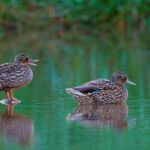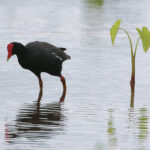Conservation groups voice concern for native birds with H5N1 on Oahu


The first confirmed cases of highly pathogenic avian influenza on Oahu is worrisome news for those dedicated to protecting endangered birds.
Until November there had been no confirmed detections of H5N1 in the Hawaiian Isles.
ADVERTISING
By mid-November that was no longer the case, with positive detections in a backyard flock of rescued ducks in Wahiawa as well as in a randomly tested wild duck on Oahu’s North Shore.
Hawaii was the last of 50 U.S. states to detect HPAI in wild birds.
The risk to humans is low, state health officials said, but those who have long worked to protect and rehabilitate Hawaii’s native waterbirds are on high alert as the virus has become a wildlife conservation issue.
“It alarms me,” said Helen Raine, Hawaii conservation coordinator for the nonprofit Pacific Birds Habitat Joint Venture. “There have been mass die-offs on the mainland, so we do need to take it seriously.”
Raine is concerned the disease could affect some of Hawaii’s native waterbirds found nowhere else in the world.
Many of Hawaii’s endangered and threatened seabirds are already dwindling in population due to other challenges, including habitat loss and climate change.
These are culturally important birds, she said, such as the Hawaiian common gallinule, or alae ula, which she describes as a charismatic black bird with a distinctive red shield that can be found near wetlands.
The alae ula, a culturally important species, has been lost from all Hawaiian Isles except Kauai and Oahu.
A recent population estimate by the U.S. Geological Society found alae ula have declined over the past five years, with just 712 birds remaining.
“An outbreak of HPAI avian influenza is a frightening prospect for this endangered species,” she said, “as the disease has a high mortality rate in birds.”
Other native birds she’s concerned about include the Hawaiian stilt, or aeo, with only about 1,500 remaining, and the Hawaiian duck, or koloa maoli, with only an estimated 673 remaining.
The nene, Hawaii’s state bird and native goose, also may be at risk.
She is concerned the virus will eventually spread to other isles, where these endangered species reside.
Wild bird route
How did HPAI arrive in Hawaii?
All indicators so far point to spillover from migratory birds via the Pacific Flyway — a broad-ranging route that stretches from Alaska down to Patagonia, including the Hawaiian Isles.
At Susie’s Duck Sanctuary, a number of pet mallard and Muscovy ducks, along with a goose and a wild zebra dove, tested positive for the Eurasian strain of H5N1, which is associated with migratory birds.
Seventy either died of illness or were euthanized.
The national lab determined they were infected with the A3 genotype of the virus. This genotype, first identified in wild birds in Alaska in 2022, is different from the one infecting dairy cows in California.
On Nov. 25 the state Agriculture Department announced a positive detection of HPAI in a wild duck on Oahu’s North Shore.
The U.S. Fish and Wildlife Service confirmed the duck was tested at James Campbell National Wildlife Refuge in Kahuku.
Sampling for avian influenza was done during an ongoing USFWS genetics project. The part-mallard duck showed no signs of infection when tested, officials said.
“At the time of testing, all birds appeared healthy, showing no signs of infection, and were released,” said USFWS in a statement. “All genetic sampling was done prior to the initial avian influenza discovery on Oahu.”
The national lab confirmed HPAI in the duck Nov. 25, marking Hawaii’s first detection of the virus in a wild bird. Hawaii was the last of 50 U.S. states to detect HPAI in wild birds.
Josh Fisher, an invasive species biologist with USFWS, was not entirely surprised, given that the virus has been circulating among migratory birds in North and South America for the past two years.
There have been detections of HPAI in all kinds of U.S. wild birds since January 2022 — from a barn owl in California to cackling geese in Oregon and rock pigeons in Utah.
Hawaii’s remote location may have slowed the spread, but the isles are along the Pacific Flyway, and the virus in 2023 reached the secluded Galapagos Islands off Ecuador.
Up to an estimated 60 bird species migrate to Hawaii, according to Fisher, including routine, occasional and rare visitors.
Some examples of migrating birds include the Pacific golden plovers, or kolea, that commonly fly from Alaska to Hawaii every fall.
Every once in a while, a rare hawk or gull blown off course also ends up in Hawaii, said Fisher, but they generally do not stay for long.
USFWS continues to monitor all lands that are part of the National Wildlife Refuge System for mortality events like H5NI that might affect species within lands and waters it oversees.
Susan Scott, president of the Hawaii Audubon Society, has advised that those who feed wild birds pause doing so for now to prevent various species from gathering until more is known.
People feed wild birds, she said, because they get a lot of joy from the connection to nature.
Eric VanderWerf, executive director of Pacific Rim Conservation, is also concerned for native seabirds and endangered wetland birds.
“Avian flu has had serious impacts on a variety of species worldwide,” VanderWerf said. “We’re fortunate that we haven’t had it in Hawaii previously. It’s a function probably of our remoteness.”
Brad Keitt, oceans and islands director for the American Bird Conservancy, said the virus’ arrival to Hawaii is bad news, considering millions of wild seabirds have died globally from avian influenza.
“We do not know how vulnerable Hawaii’s birds are to this threat,” said Keitt, “but expect the greatest risk to be for water and wetland birds such as ducks, stilts and coots and seabirds, such as boobies, shearwaters and terns.”
He added, “In other locations around the world, avian flu has caused large mortality events, and we can only hope this does not happen in Hawaii.”
When avian flu reached the Galapagos Islands in 2023, he said, land managers shut down visitation to isles with vulnerable populations, which appeared to have some impact after a year.
“We definitely want to keep this out of the Northwestern Hawaiian Islands, where most bird colonies are, or Lehua off of Kauai,” he said.
Risk to humans is low
The state Department of Health, meanwhile, says the risk to the general public in the state remains low.
While the avian flu is contagious among birds, with the potential to infect common Hawaii backyard birds such as mynahs, bulbuls and zebra doves, DOH said there has been no definitive evidence of human-to-human transmission of the H5N1 virus in the U.S.
Dozens of people with potential exposure at the Nov. 2 Mililani Pet Fair, where some of the ducks that later became ill were present, have tested negative, according to the department.
Alex Lehrer, medical microbiology professor at the John A. Burns School of Medicine, said it is important to remain vigilant but that the immediate health risk is low.
Flu viruses spread quickly because they are respiratory viruses, he said, but avian flu is designed to replicate well in the cells of birds.
“This has to do with the structure of the surface proteins and so on,” he said, “so at this point they’re not an immediate concern for humans and for other mammals.”
In North America there have so far been three human H5N1 cases without known exposure to animals in a Missouri patient; a teen who became critically ill in Canada; and a child with mild symptoms in Alameda County, Calif.
Lehrer said these are isolated cases, however. The virus can mutate to become more adept at infecting humans and mammals, but this can be significantly slowed by reducing risks.
As of Friday the Centers for Disease Control and Prevention confirmed 58 human cases of H5N1 in the U.S., mostly among dairy workers.
CDC also counted more than 700 confirmed cattle herds in 15 U.S. states. The epicenter is now in California, where more than 500 dairy herds and more than 30 people have been infected.
USDA on Friday announced it will begin testing the nation’s milk supply for H5N1, using samples of unpasteurized milk from dairy processing facilities across the U.S.






